
This page contains the following solutions.
Omniscience would have to be very boring. The real mystery here is what drives this plant to make a last ditch effort to continue its own kind. In its final hours, with the rest of the plant almost gone, it produced one of the largest flowers of its lifetime.
I bought a hibiscus plant at a flea market; the vendor told me it was a perenniel for our area of the country. She said that the "old wood" should not be cut back at the end of the season, it should be mulched for the winter months; in the spring the mulch should be removed and feeding should begin.
Here are the questions asked by community members. Read on to see the answers provided by the ThriftyFun community.
This is as far as it would open. Previous years' blooms were beautiful.
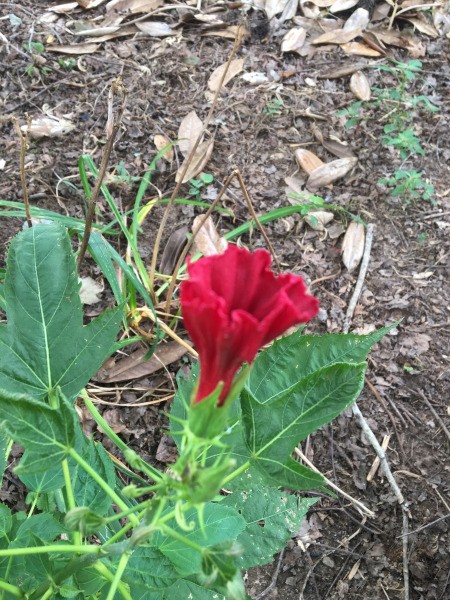
The problem could be insects, especially thrips which feed off the flower. This causes the buds to fall off before blooming.
I have many hibiscus plans and several seem stressed. What can I do to help them?

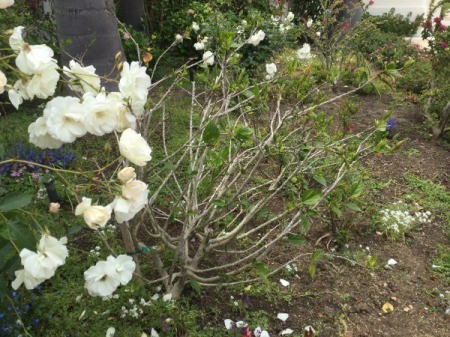
Hibiscus like acid soil so get peat moss or potting soil for it.
It looks like these are well established hibiscus plants so they must have been in the ground for several years. Your zone must be in the high numbers or these plants would not have survived the winter months.
www.gardeningknowhow.com/
Last year I was having trouble with the leaves on my hibiscus cupping very badly. Also with a Black-eyed Susan, the leaves weren't cupped, but deformed and scarred. I came to the conclusion that they had powdery mildew; all symptoms seemed to point in that direction.
This year they both came up looking perfectly fine and healthy. They were growing as they should. Then they started to look a little tattered as time passed. Of course I gave them a good shot of soapy water and fed them. I staked the hibiscus for support against the wind. They just slowly started looking worse.
I think I was incorrect in my diagnosis of powdery mildew last year. We get a lot of wind here for several days in a row at times (20 to 30 mph gusts and 15 to 20 sustained). There is nothing on this side of the house for a wind break. I placed some bricks, with 3 holes in them, a little way in front of the flower beds that were the worst target for the wind. In just 1 week the Black-eyed Susan was showing a great deal of improvement. Now it is sporting several buds. The hibiscus plants however are more toward the back of the bed and are too tall for these small bricks to make a much of a deflection against the wind. The hibiscus looks just as they did last year, there is very pronounced cupping of the leaves (most especially the newer leaves).
I am going to move them to a new location where maybe they'll be somewhat protected from the harsh winds. It is, however, in a partly shaded area. Can plants actually get mildew in an area where there is rarely any humidity or rain? We live in zone 5 in the very southeast corner of Colorado, the very southwest corner of Kansas, and just north of the Oklahoma panhandle.
We are now in the process of planting as many lilac bushes as we can around the property for a windbreak. I planted an assortment of 9 shrubs last year for this very purpose. Not nearly enough to cover the area we need covered in the country. I don't have the time to wait for those 9 shrubs to grow into a windbreak. They were planted in well thought out places, with the intent to fill in the gaps by adding a few new shrubs every year. But it is what it is and I have 6 very mature lilac bushes that have oodles of shoots just begging to be dug up. I just transplanted 10 in a line on the problem side of the property and we're not halfway through digging holes yet! I hope that deflecting the wind improves the growing conditions on that side if the house. So many ideas, but nothing seems to grow well there.
So, I guess the question is, what kind of wind can a hibiscus tolerate and what would the damage to the plant entail? I could be wrong again about the wind, too. The plants leaves are cupped and they just look altogether fatigued.
By LorindaWalshCO from Walsh, CO
I wasn't able to load a picture of my poor hibiscus plants when I sent my question .... I am going to try now & hope it works.
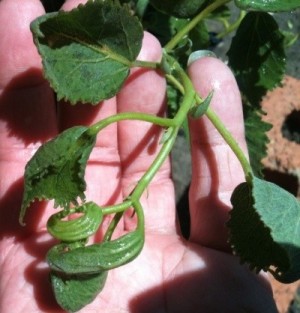
I am having the same problem and I read that stress on the plant or too much nitrogen can be the cause. I did use a different type of fertilizer this year so who knows. Last year this did not happen and it is these plants second year.
My hardy hibiscus has done this cupping for the first time this year. I read where someone said that excess rain could produce excess nitrogen and hurt the plants, which we had an extreme abundance of ran almost every day this spring. Someone else said broad mites. I do have the hibiscus planted next to some purple bee balm which is notorious for getting powdery mildew though.
I have an potted hibiscus that is almost 5 feet tall and blooms continuously all winter. In the summer I put it outside in a partly sunny location and it remains healthy, but does not flower.
What am I doing wrong?Prune back 1/3 in late spring or early summer.
Last year was the first time I tried hardy hibiscus. I got roots from a mail order catalog and planted them in late spring with plenty of sun. We have very sandy soil so I water often, every 2 days, saturating the soil. The leaves on all 3 plants are cupped to such an extreme that the new leaves look like miniature lobster claws. The older leaves look like little boats. They haven't lost any leaves, they are still growing and there is no yellowing.
The biggest plant hasn't bloomed at all. The second biggest plant had 2 blooms, the smallest had 3 buds; 2 small buds that dried up and fell off. The 3rd bud did bloom. Both flowers had beautiful color (white with a burgundy center), but they didn't open up the way they should. They weren't as big as the ones I've seen on plants not 4 hours from here. There were spaces between the petals. The petals were sort of long and slender.I also have Black-Eyed Susan at the end of this same bed with some leaves misshapen and having bronze like spots on tops and under sides of leaves, as well as a fringe of bronze around the edges. These flowers are small, but otherwise look normal. They aren't a year old yet, so maybe small blooms are normal?
Has my bed got some sort of disease? Or are they starving for nutrients? I've fed them liquid iron 2X in the last month, added organic granules to the soil when they first came up in spring and drenched them with a 20-20-20 soluble food 1 or 2 times in the last 2 weeks, thinking it might help. I don't want to give them too much food for fear of causing more problems. These are the only plants effected in that bed, the sedum and Red-Hot Pokers are fine. Anyone?
By LorindaWalshCO from Walsh, CO
Never mind. Day after day I have searched the web for an answer, and asked everyone I talked to if they might know what is wrong with my poor pathetic flowers. No answers could I find. Then last night I figured it out! And all by my desperate self. Both the hibiscus and the Black-Eyed Susans have powdery mildew. It appears that the disfigured leaves and spots are the prelude to the white stuff; which has now made its grand entrance.
It's really sad because, I was so excited and so proud of myself for figuring out the problem on my own, because ten minutes later both of my Black-Eyed Susans (blooms and all!) were sheared to ground! The Hibisbus will suffer the same here in a few hours. Then the treatment & recovery begin.
I didn't get to read your article before you sheared your babies down, but both will return. The powdery mildew I keep at bay by making sure my hibiscus is in a lot of sun and in the rainy season, I use dawn dish soap and bleach (doesn't take a lot) in a quart sprayer about a tsp. of each). Do it in the evening after it gets cooler and let them grow. You still probably need to fertilize the hibiscus & black eyed Susans. Remember it is a wet land type plant. Just water well in dry times and fertilize. Keep growing.
I have a hibiscus tree that I brought in this past summer and the leaves are curling in. What is going on?
Thanks.
I have no idea. I do know that several insects use webbing to draw the leaves around their nest. Do closely examine the curled leaves, both topside and bottom.
Both of these plants hibiscus grew beautiful flowers, but now seem to have some disease both on leaves and stem. Their location was changed to another part of the house, then they were brought to the original location, which has more sunlight and where they bloomed many a time, this happened.
Is there a way to treat them?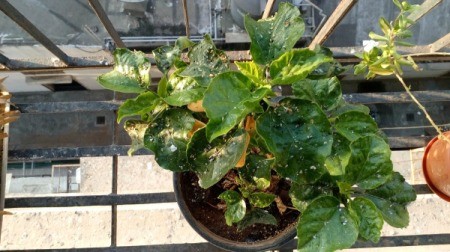
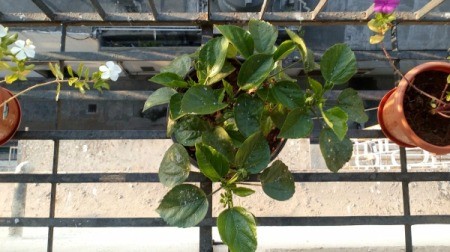
It's a little difficult to tell froom that picture but it looks like it may be whitefly, not uncommon for Hibiscus to get. Don't worry. While your Hibiscus MAY be angry and upset at this, you can save her. But you must act fast. First, start by taking Palmolive soap (MUST BE PALMOLIVE) and get one of those 1 liter spray bottles. Put in about half a tablespoon of the soap in the bottle and then fill it with water. Fill it slowly so as not to get massive foam forming iin the bottle. Make sore to shake it well so that the soap dilutes in the water. Now Spray your plant like crazy with this mixture EVERY DAY, preferably NOT when it is exposed to sun as water beads magnify sun and will burn the leaves, rendering your plant MORE unhappy. The oils in the soap are good for the leaves and your plant will ove you for it. The soap of course will dry out the eggs (most likely the white dots) and burn them as much as possible. When you can, try to wipe the leaves down CAREFULLY, and don't tear the leaves as you do so.
For how long do you spray? Well that depends on your hibiscus and how fast it helps. I would say a better part of 3 months, at least 2 EVEN if the leaves appear clean after. Also SPRAY the earth with this mix. I also recommend you water her first BEFORE spraying the earth, simply because you don't want to wash away the soapy coating that lays on the earth. For the first 3 weeks, spray her every day. After that a rate of 3 days YES and 1 day no. Soap is a little tiring for the plant too after a while and she does prefer water than soap. The oils in Palmolive will keep the leaves from drying out.
As for rubbing down the leaves, DON'T START right away! Try this after a week or so when the soap has had time to have an effect. And again, don't be afraid to over spray. Oh and, make sure to spray both on top and UNDER the leaves! White flies don't discriminate where they rest.
I just planted a variegated hibiscus and overnight something shredded/ate virtually every leaf. I live in Queensland, Australia. Could the culprit be a brush turkey?

I had lots of aphids on my hibiscus. I sprayed soapy water on it after the sun went down, but since I live in Florida, the next day there was plenty of sun. Within a few days all the leaves and buds fell off. Did I kill it or will my hibiscus come back?
By Linda from Sebastian, FL
At least 50 years ago a brother in law told me that I could determine whether a plant was still alive by scratching it on the main "trunk". If it's still green the plant is still alive. I'm sure your hibiscus is still alive. I certainly hope so! I love those things!
Check out these photos.
Last spring, I bought a hibiscus at a reduced price. It really looked bad. Its stems had the most unusual appearance. Well, for 2 dollars, why not?
In the pictures below, you will see 2 kinds of Hibiscus; the summer hibiscus, which can be planted with mulch farther north of zone 8, and the regular tropical hibiscus which can be grown as far north as the ground doesn't freeze.
I found these this morning in a neglected corner of my back yard, an area I seldom visit. This plant has been in a pot for several years. I think by rendering such a beautiful display, it is trying to tell me it is worthy of its own little parcel of terra firma.
The hibiscus is a large genus of flowering plants that are native to temperate, subtropical, and tropical climates. Winter protection allows you to enjoy them in colder area gardens. This is a page about hibiscus flower photos.
To rid your hibiscus plant of white flies spray with a mixture of 1 gallon warm water that has 1 cup sour milk and 1 Tbsp. flour added. Spray both sides of the leaves. This is a page about removing white flies from hibiscus.